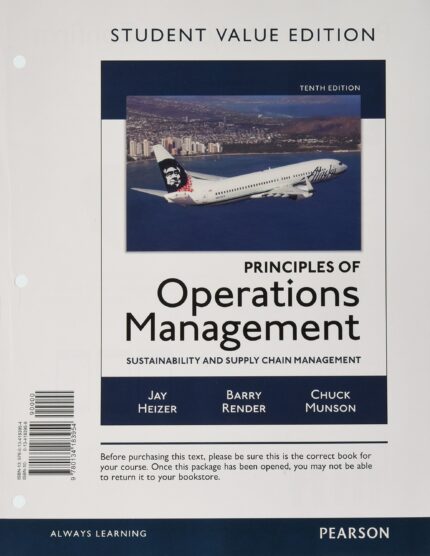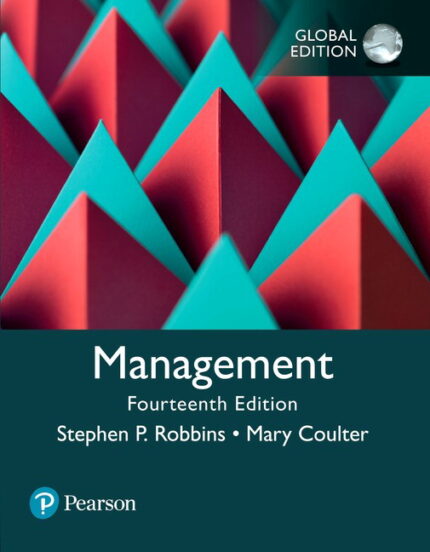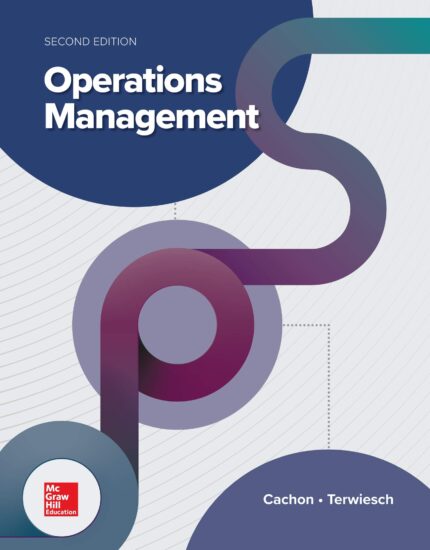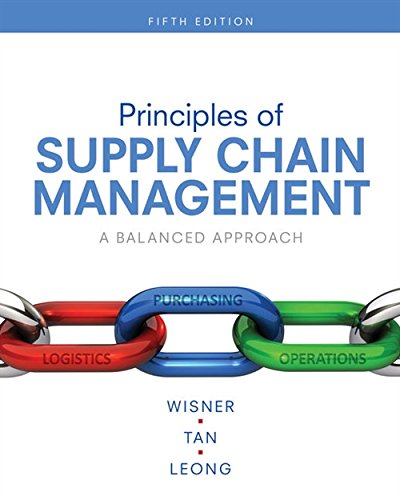Operations Management 1st Edition by Cachon – Test Bank
Chapter 03 Test Bank KEY
1. The primary purpose of a process analysis is to crowdsource new product ideas.
FALSE
The purpose of process an alysisis to improve a process.
AACSB: Analytical Thinking
Accessibility: Keyboard Navigation
Blooms: Remember
Difficulty: 1 Easy
Gradable: automatic
Learning Objective: 03-01 Draw a process flow diagram.
Topic: How to Draw a Process Flow Diagram
2. The capacity of a resource is the average flow rate of that resource.
FALSE
The capacity of a resource is the maximum number of flow units that can flow through that resource per unit of time.
AACSB: Analytical Thinking
Accessibility: Keyboard Navigation
Blooms: Remember
Difficulty: 1 Easy
Gradable: automatic
Learning Objective: 03-02 Determine the capacity for a one-step process.
Topic: Capacity for a One-Step Process
3. Cycle time is the same as lead time.
FALSE
Cycle time is the time between completing two consecutive flow units, whereas lead time is the time between when an order is placed and when it is received.
AACSB: Analytical Thinking
Accessibility: Keyboard Navigation
Blooms: Understand
Difficulty: 2 Medium
Gradable: automatic
Learning Objective: 03-03 Determine the flow rate, the utilization, and the cycle time of a process.
Topic: How to Compute Flow Rate, Utilization, and Cycle Time
4. A bottleneck is the resource with the lowest capacity.
TRUE
A bottleneck is the resource with the lowest capacity in a multi-step process.
AACSB: Analytical Thinking
Accessibility: Keyboard Navigation
Blooms: Understand
Difficulty: 2 Medium
Gradable: automatic
Learning Objective: 03-04 Find the bottleneck of a multi-step process and determine its capacity.
Topic: How to Analyze a Multistep Process and Locate the Bottleneck
5. A resource with a utilization of less than 100% is never the bottleneck.
FALSE
When the process is demand-constrained, even the bottleneck will have a utilization of strictly less than 100%
AACSB: Analytical Thinking
Accessibility: Keyboard Navigation
Blooms: Understand
Difficulty: 2 Medium
Gradable: automatic
Learning Objective: 03-04 Find the bottleneck of a multi-step process and determine its capacity.
Topic: How to Analyze a Multistep Process and Locate the Bottleneck
6. It matters whether the process starts empty or not when computing the time it takes to produce a certain order quantity.
TRUE
If the process is already running, the time it takes to produce X units is equal to Cycle time of the process × X. If the process starts empty, the time it takes to produce the first unit should be added to Cycle time of the process × (X – 1).
AACSB: Analytical Thinking
Accessibility: Keyboard Navigation
Blooms: Remember
Difficulty: 1 Easy
Gradable: automatic
Learning Objective: 03-05 Determine how long it takes to produce a certain order quantity.
Topic: The Time to Produce a Certain Quantity
7. Which of the following statements about process analysis is TRUE?
A. Process analysis only matters to those who are in accounting.
B. Process analysis is all about keeping track of revenue and costs.
C. Process analysis is all about creating demand.
D. Process analysis helps one analyze all the activities involved in providing one unit of supply.
Process analysis helps in analyzing a process to make improvements.
AACSB: Analytical Thinking
Accessibility: Keyboard Navigation
Blooms: Remember
Difficulty: 1 Easy
Gradable: automatic
Learning Objective: 03-01 Draw a process flow diagram.
Topic: How to Draw a Process Flow Diagram
8. Resources are shown in a process flow diagram as:
A. boxes.
B. arrows.
C. spheres.
D. triangles.
Resources are represented as boxes in a process flow diagram.
AACSB: Analytical Thinking
Accessibility: Keyboard Navigation
Blooms: Remember
Difficulty: 1 Easy
Gradable: automatic
Learning Objective: 03-01 Draw a process flow diagram.
Topic: How to Draw a Process Flow Diagram
9. Inventory is shown as ____________ in a process flow diagram.
A. boxes
B. arrows
C. spheres
D. triangles
Inventory is shown as triangles in a process flow diagram.
AACSB: Analytical Thinking
Accessibility: Keyboard Navigation
Blooms: Remember
Difficulty: 1 Easy
Gradable: automatic
Learning Objective: 03-01 Draw a process flow diagram.
Topic: How to Draw a Process Flow Diagram
10. Which of the following is a resource in an outpatient clinic?
A. Flu shot
B. X-ray machine
C. Ambulance
D. Reputation
Equipment such as an X-ray machine is a resource at an outpatient clinic.
AACSB: Analytical Thinking
Accessibility: Keyboard Navigation
Blooms: Understand
Difficulty: 2 Medium
Gradable: automatic
Learning Objective: 03-01 Draw a process flow diagram.
Topic: How to Draw a Process Flow Diagram
11. You are filling your prescription at a pharmacy and are waiting in line in front of the pickup window. Which one of the following processes will be upstream relative to your current position in the process?
A. Paying for the prescription
B. Waiting to take the prescription
C. Inspecting the prescription
D. Dropping off the prescription
You have to drop off the prescription before picking it up.
AACSB: Analytical Thinking
Accessibility: Keyboard Navigation
Blooms: Understand
Difficulty: 2 Medium
Gradable: automatic
Learning Objective: 03-01 Draw a process flow diagram.
Topic: How to Draw a Process Flow Diagram
12. _______________ are used to show the journey of a flow unit from input to output.
A. Boxes
B. Arrows
C. Spheres
D. Triangles
Arrows are used to show the journey of a flow unit from input to output.
AACSB: Analytical Thinking
Accessibility: Keyboard Navigation
Blooms: Remember
Difficulty: 1 Easy
Gradable: automatic
Learning Objective: 03-01 Draw a process flow diagram.
Topic: How to Draw a Process Flow Diagram
13. Refer to the process flow diagram below. Station 1 is at the ______________ of the process.
A. downstream
B. upstream
C. target
D. bottleneck
The beginning of the flow (where Station 1 is) is called the upstream of the process.
AACSB: Analytical Thinking
Blooms: Understand
Difficulty: 2 Medium
Gradable: automatic
Learning Objective: 03-01 Draw a process flow diagram.
Topic: How to Draw a Process Flow Diagram














Reviews
There are no reviews yet.